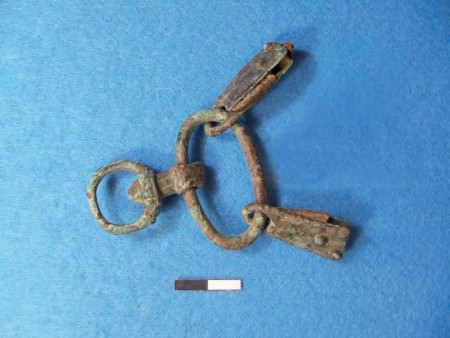Most Italian necklaces were just simple strands of pearls, sometimes with a pendant attached. Many portraits, when looked at closely, show some sort of spacer between each pearl. Most likely many of these "spacers" were knots in the stringing cord, which are still used today for both security (in case the thread broke) and to keep the pearls from rubbing on each other. However, in quite a few instances the spacers seem to be tiny metal beads, such as in the 1544-45 portrait of Eleonora of Toledo with her son Giovanni de' Medici (by Agnolo Bronzino; Galleria degli Uffizi, Florence):
Or in this one of Lucrezia de' Medici, c1560 (by Alessandro Allori; North Carolina Museum of Art):
Presumably these tiny beads served the same purpose as the knots, but with the added bonus of a subtle sparkle! Of course, with my love of sparkle, I opted for using tiny gold beads in my ACC necklace:
Wherein I chronicle the triumphs and woes of my crafty life
Labels
ACC
zibellini
Astrid's zibie
Holly's DOOOOM project
zombellino
fans
fox zibie
mosaics
rings
Bronzino portrait project
Sofonisba
belt
blue velvet zimarra
bracelets
buttons
chain maille
clock zibie
dogs
earrings
flag fan
gold brocade kirtle
jewelry
necklace
necklace; verre eglomise; pendant
patterning
portraits
zibitty
Tuesday, September 27, 2011
ACC: Rings - first style
I ended up getting four different colors of stones to see which one I liked best. I decided that I liked them all! So, although I'm only going to use the red one for the ACC, I included the others in the pic so you can see all the purty colors! :)
I haven't decided whether I'm going to sell the others or keep them...hmmm...
I haven't decided whether I'm going to sell the others or keep them...hmmm...
Saturday, September 10, 2011
Diana the Zibellino
Diana was created for the Province of Arrows' Flight (http://www.arrows-flight.o
Thursday, September 8, 2011
A small digression...
Even though this isn't craft related, it is an extant medieval object relating to my other great love: dogs! (Text and picture from this article on the 2010-2011 Scotland Treasure Trove Report.)
Swivel ring and mount for a medieval hunting leash

This is an unusual complete example of a swivel fitting for a dog leash, comprising a freely rotating mount with attachments for two separate leashes. Such leashes were used to control dogs during hunting where the swilling element would prevent the leashes being fouled or caught. The fitting is rather small and is presumably for a pair of scent hounds or dogs for small game such as hare. Hunting held a particular place in medieval culture, putting an emphasis on particular behaviour and virtues. It was in short, a social setting where an individual could show themselves to advantage and this objects reflects this social setting; finely decorated, it is an object to be admired and to reflect the status of the owner as much as it is a utilitarian object.
Swivel ring and mount for a medieval hunting leash

This is an unusual complete example of a swivel fitting for a dog leash, comprising a freely rotating mount with attachments for two separate leashes. Such leashes were used to control dogs during hunting where the swilling element would prevent the leashes being fouled or caught. The fitting is rather small and is presumably for a pair of scent hounds or dogs for small game such as hare. Hunting held a particular place in medieval culture, putting an emphasis on particular behaviour and virtues. It was in short, a social setting where an individual could show themselves to advantage and this objects reflects this social setting; finely decorated, it is an object to be admired and to reflect the status of the owner as much as it is a utilitarian object.
Subscribe to:
Posts (Atom)






